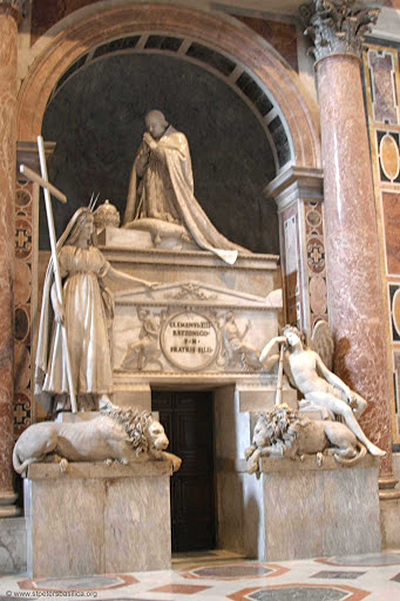Antonio Canova worked on the design for this tomb between the years of 1783 to 1792. It would feature several figurative sculptures plus two lions at the foot of the construction. Clement XIII is represented at the top, kneeling whilst in prayer.
The sculptor would use travertine for the lions, with white Carrara marble for the rest of the display. He would work on several tomb designs during his career, with Tomb of Clemens XIV and Funeral Monument to Maria Cristina of Austria also being highly memorable and underlining the variety found across his career. St Peter's Basilica plays as host to the Tomb of Pope Clement XIII, marking it out as one of his highest profile projects. Michelangelo himself would work here on a number of occasions several centuries earlier and to follow in the footsteps of such masters would have been a huge honour for Canova. There would also be a huge gain for him professionally as a result of projects such as this, which would then make it much easier for him to find future projects from other patrons who, no doubt, would be delighted to hire the services of someone deemed good enough for the Basilica. Canova was an ambitious individual who loved to obtain the biggest commissions, in a similar way to how Michelangelo would always be looking for the next big project, even when working on existing tasks.
Another sculptor featured within this Basilica would be the great Gian Lorenzo Bernini. He was just as highly regarded as Canova, perhaps even more so. His career was wide and varied, though some of the highlights included the likes of Apollo and Daphne, Ecstasy of Saint Teresa and St. Peter's Baldachin. Some consider Canova's contributions to have been more innovative, due to the "greater spatial depth", as well as the switching of content to something more related to "Pagan Allegories". In truth, both sculptors are almost beyond criticism such is the level of achievement that they both reached by the end of their respective careers. Italy remains the centre of sculpture when considering a period of many centuries, whilst today the influences are spread all across the world, and one cannot easily pinpoint a particular location or hub of influence. Both artists would actually work across different mediums and were able to leverage their studios in order to maximise their own artistic development.
At the foot of the tomb you will find the two lion sculptures which have become known as the Canova Lions. A copy of these beautiful pieces were made in bronze and now are out on display in Washington D.C., USA, just outside the entrance of the Corcoran School of the Arts and Design, which was originally known as the Corcoran Gallery of Art. They have become a key part of the cultural offering of this city and are much loved, even with people who are unaware of their connection to one of the finest Italian sculptors in history, Antonio Canova. Comparisons can be drawn with the Landseer lions that sit at the base of Nelson's Column in central London, UK. It is delightful to find Canova's work becoming a permanent fixture within the US city, and those copies are believed to have remained there unmoved since as early as 1860. This again shows an advantage of sculpture, where several legitimate copies can be made from a single mould, and as long as it is the original artist that handles the process, then each iteration will still retain considerable academic interest and a considerable monetary value.




